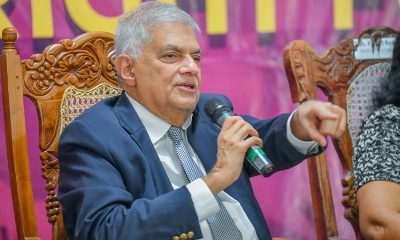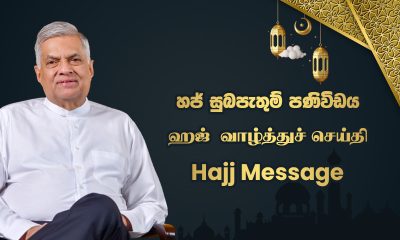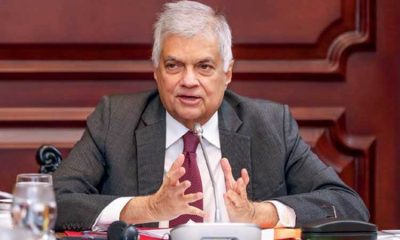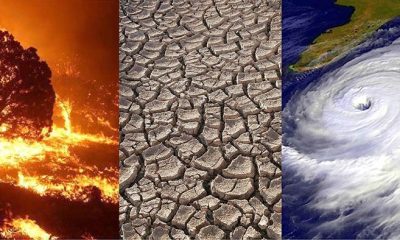Midweek Review
Prez takes Trinco Oil Tank Farm to next level
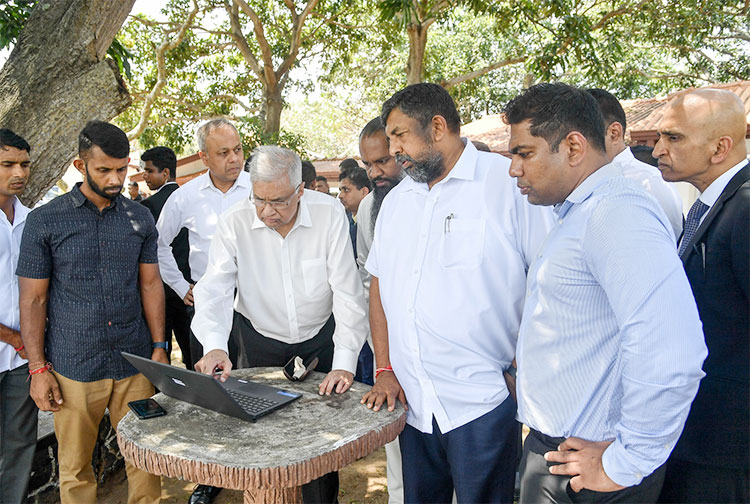
By Shamindra Ferdinando
A pair of Chinese built F-7 multi-role jet fighters flew over SLAF China Bay parade grounds, within minutes after President Ranil Wickremesinghe arrived there, on March 03, to take the salute, as the Chief Guest, at a Commissioning and Wings parade of the No 65 Officer Cadets’ Intake, comprising a total of 40 officers, belonging to No. 17 Lady Officer Cadets’ Intake, and the No. 35 and No. 37 Kotelawala Defence University (KDU) Intakes.
F7s flew from Katunayake air base, the home to the famed No. 05 Squadron that played a significant role, during the Eelam War IV (August 2006-May 2009).
The Commissioning and Wings parade coincided with the 72nd anniversary of the Sri Lanka Air Force (SLAF). The F-7 GS’ flew immediately after President Wickremesinghe, who is also the Commander-in-Chief of the armed forces, arrived at the saluting dais.
It would be pertinent to mention that SLAF Chief, Air Marshal Sudarshana Pathirana, veteran jet pilot, on whose invitation President Wickremesinghe attended the China Bay event, was among the three-member group that recommended the acquisition of Chinese interceptors, in 2007, as the war had entered its final phase, which was undoubtedly a fight to the finish against ‘the world’s most ruthless terrorist outfit’, with a formidable fighting force, comprising naval, air, and land capabilities, all of whose signature modus operandi was the suicide attack.
The group consisted of the then Group Captain Priyantha Gunasinghe (retired in the rank of Group Captain), Group Captain Sudarshana Pathirana and Wing Commander Sajeewa Hendawitharane (retired in the rank of Group Captain) asserted that the Chinese interceptors should be acquired to counter immediate LTTE air threat, and the other available aircraft, at that time, MiG 29s, acquired from Ukraine, should be considered as a long-term solution. This decision was made soon after the LTTE carried out its first air attack on the Katunayake air base, in March 2007. F-7 GS were first flown here, in January 2008. The No. 05 Squadron achieved a 5-6 minute reaction time during a scramble and was the Squadron to be on 24-hour stand by, in an interceptor role, since its deployment in early 2008.
By the time the LTTE was brought to its knees, on the Vanni east front, in May 2009, the four Chinese jets had registered altogether 506 missions. During the last phase of the ground offensive, the then Air Force Commander, Air Marshal Roshan Goonetilleke, moved a pair of those jets to China Bay, in case the top LTTE leadership made an attempt to escape, by sea. At that height of the war, the SLAF jet Squadrons consisted of Kfirs, MiG 27s and F-7s.
On the day of the China Bay parade, the writer was invited to deliver a lecture at the Naval and Maritime Academy, Trincomalee (32nd JNSC course) on ‘media management’ in armed forces or ‘military and media management.’
Well over a decade after Sri Lanka’s triumph over the Liberation Tigers of Tamil Eelam (LTTE), the country is in a bind with the government seeking USD 2.9 bn IMF bailout package. No less a person than theGovernor of the Central Bank, Dr. Nandalal Weerasinghe, recently alleged that the government had been hiding Sri Lanka’s bankruptcy status before he admitted the reality, a couple of moons ago. In an utterly destabilized environment, every sector seems to be in turmoil, no doubt exacerbated by a combination of events, including the 2019 Easter Sunday suicide attacks, crippling the vibrant tourist trade, the Covid-19 pandemic, something not scene in our living memory, hitting the whole world, the following year, thereby robbing the country’s financial sector of vital worker remittances, running to billions of dollars, by underground money transfer systems.
The armed forces are certainly not exempted. The ongoing controversy, over a three-member committee, comprising Admiral of the Fleet Wasantha Karannagoda (Governor, North Western Province), Air Chief Marshall Roshan Goonatilleke (Governor, Western Province) and ex-Army Commander Daya Ratnayake, finding fault with the then Army Commander, Gen. Shavendra Silva, for his alleged failure to bring the 09 May, 2022, violence swiftly under control. The reportage of the unexpected development is a serious challenge to those responsible for media management in armed forces. This contentious issue cannot be discussed without taking into consideration (i) Gen. Silva, the first General Officer Commanding (GOC) of the famed 58 Division (formerly Task Force 1) is the incumbent Chief of Defence Staff (ii) The role played by those at Temple Trees in instigating a hooligan attack on Galle Face protesters and (iii) the ferocity of counter meticulous attacks, mounted by well-organized groups across the country, against those in power.
The continuing economic-political-social crisis has destabilized the country to such an extent with political parties, represented in Parliament, hell-bent on advancing their own agendas, regardless of the consequences.
Like Gen. Shavendra Silva’s controversial conduct, during the events that led to the forced ouster of President Gotabaya Rajapaksa, after having been one of the significant frontline ground commanders, who took the fight to the LTTE, resulting in its eventual defeat, similarly while everyone talks about a IMF bailout to no end, day in day out, critics are legitimately asking whether all this financial turmoil was deliberately created by interested parties and even those in the highest echelons of the government have not done anything tangible to get back USD billions from export proceeds that had been parked overseas, by unscrupulous exporters, as that amount alone is enough for us to climb out of the present rut.
New move on Trinco oil tank farm
Having participated at the China Bay parade, President Wickremesinghe, accompanied by National Security Advisor and Chief of Presidential Staff, Sagala Ratnayake, and several others, including Power and Energy Minister Kanchana Wijesekera, toured the Trincomalee Oil Tank Farm, consisting originally of 100 tanks, situated in 827 acres of land. The tank No. 91, however, was destroyed in Japanese air attacks, launched by ship-borne bombers, and attack aircraft, during World War 11. President Wickremesinghe is the first head of state to visit the Oil Tank Farm since Sri Lanka handed it over to Lanka Indian Oil Company (LIOC) during his previous tenure as the Prime Minister. The Oil Tank Farm is situated in China Bay. Managing Director of LIOC, Manoj Gupta, was there to welcome President Wickremesinghe.
In terms of the agreement, finalized on 07 February, 2003, during Chandrika Bandaranaike Kumaratunga’s tenure as the President, the LIOC took over the 99 oil tanks, each capable of holding 12,300 tonnes (1 tonne =1,000 litres) of fuel. The upper and lower tank farms consist of 85 tanks and 14 tanks, respectively.
On behalf of Sri Lanka, the then Secretary to the Treasury, Jayampathy Charitha Ratwatte ,signed the agreement, operative for a period of 35 years. In fact, the Trincomalee facility is so far covered by three agreements, namely (i) the Indo-Lanka Accord of 29 July, 1987, signed by President JRJ and PM Rajiv Gandhi (ii) the agreement on taking over of possession and related matters of the China Bay installation of the Ceylon Petroleum Corporation (CPC), signed on 07 February, 2003, and (iii) comprehensive agreement on cooperation in economic projects, finalized on 26 April, 2017, by Indian External Affairs Minister Sushma Swaraj and Development Strategies and International Trade Minister Malik Samarawickrema.
President Wickemesinghe declared, at China Bay, in no uncertain terms, the urgent need to go ahead with the Oil Tank Farm development project.
In line with the government’s overall strategy, President Wickremesinghe recently brought in one-time Navy Commander, Admiral Ravi Wijegunaratne, as the Managing Director of the Ceylon Petroleum Corporation (CPC), and to its Director Board as President’s nominee, and also as Chairman, CPC Trincomalee Oil Tank Farm Development Company. The Director Board consists of eight-four each from Sri Lanka and India. The CPC /LIOC venture is meant to speed up the entire process. National Security Advisor Sagala Ratnayake is working on this project.
Of the 99 tanks, 61 tanks are empty. President Wickremesinghe is keen to restore the unused 61 tanks to working condition. Would it be possible to store here what can be safely called the strategic Indian oil reserves?
Indian response to the 80s threat
On 29 July, 1987, President JRJ and Premier Rajiv Gandhi exchanged letters which dealt with the Trincomalee Oil Tank Farm as part of the controversial Indo-Lanka Accord. They essentially addressed security issues, against the backdrop of the then growing Indian concerns that foreign military, and intelligence personnel, posed a serious threat to India. India never acknowledged that Sri Lanka wouldn’t have had to seek foreign military assistance if not for its then Premier Indira Gandhi launching a destabilisation project here by covertly training Sri Lankan Tamil armed groups, as a direct counter to then Sri Lankan President JRJ’s overt pro-Western stand, by even offering Trincomalee as a base to Washington.
India included the Trincomalee Oil Tank Farm in the agreement that was meant to bring the situation under control. But, at the end of its direct intervention, India had lost 1,300 officers and men, over double that number wounded, and Rajiv Gandhi himself was blown up, in Tamil Nadu, by a female Tiger suicide bomber. It was the price India paid for interfering in Sri Lanka’s internal affairs.
At the time New Delhi’s hand was also forced by covert Western actions to destabilize and, possibly, break up India, by backing various separatist groups there. So, in a way, the Tamil separatist movement here was hijacked by the West to sow discord in India, where there are more than 60 million Tamils. The West, led by the USA and the UK, was all out to finish off India, even using Pakistan as a proxy because it was seen as being too close to the then Soviet Union. But they were halted, in their tracks, because of the solid backing that New Delhi received from Moscow, the then countervailing military power. Later, with the collapse of the Soviet Union, in the late 80s, the West found a new convenient mortal enemy in Islamic terrorists, who were in the first place incubated, in Pakistan and Afghanistan, by Washington, to chase out Russians from the latter, with the backing of wealthy Arab countries, like Saudi Arabia.
So those in Delhi should be aware that if there was no China, India would have been the West’s current number two target, after Russia. These pale faces are essentially and, undoubtedly, evil, especially if one looks at what they have done around the world by plundering and enslaving the weakest, while outwardly professing ‘all men are created equal’. At least the Russians, after their October revolution, helped to free many of the enslaved colonies. All those colonies were given independence, for fear of the spread of Communism, and certainly not because the colonial powers suddenly became enlightened.
Let me reproduce the letter, dated 29 July, 1987, signed by Rajiv Gandhi.
” (1) Conscious of the friendship between our two countries, stretching over two millennia, and more, and recognizing the importance of nurturing this traditional friendship, it is imperative that both Sri Lanka and India reaffirm the decision not to allow our respective territories to be used for activities, prejudicial to each other’s unity, territorial integrity and security.
(2) In this spirit, you had during the course of our discussions, agreed to meet some of India’s concerns as follows: (i) Your Excellency and myself will reach an early understanding about the relevance and employment of foreign military and intelligence personnel with a view to ensuring that such presence will not prejudice Indo-Sri Lankan relations; (ii) Trincomalee, or any other ports in Sri Lanka, will not be made available for military use by any country in a manner prejudicial to India’s interests; (iii) The work of restoring and operating the Trincomalee Oil Tank Farm will be undertaken as a joint venture between India and Sri Lanka; (iv) Sri Lanka’s agreement with broadcasting organizations will be reviewed to ensure that any facilities set up by them in Sri Lanka are solely used as public broadcasting facilities and not for any military or intelligence purposes.
(3) In the same spirit India will: (i) Deport all Sri Lankan citizens who are found to be engaging in terrorist activities or advocating separatism or secessionism (ii) provide training facilities and military supplies for Sri Lankan security forces
(4) India and Sri Lanka have agreed to set up a joint consultative mechanism to continuously review matters of common concern in the light of the objectives stated in para 1 and specifically to monitor the implementation of other matters contained in this letter.
(5) Kindly confirm Excellency that the above correctly sets out the agreement reached between us. Please accept, Excellency, the assurances of my highest consideration.”
India raised concerns particularly over US and Israeli presence in the 80s. But, today, India is part of the Quadrilateral Security Dialogue (QSD), widely known as the Quad, formed to meet what the US, Japan, Australia and India perceived as the growing Chinese challenge. Sri Lanka is caught up in the Quad politics due to heavy Chinese investments here, particularly the leasing of the Hambantota Port, for a period of 99-years, to China, in 2017, by the Yahapalana government. But what is really interesting is that the same government finalized a wide ranging memorandum of understanding for cooperation in economic projects, on 26 April, 2017, with India, that covered the Trincomalee Oil Tank Farm, eight months before China secured 85 percent of shares in the Hambantota Port for USD 1.12 bn.
Media management in armed forces
While the writer was working on the presentation for JNSC, the US embassy, in Colombo, in a joint press release with Sir John Kotelawela Defence University (KDU), dealt with the launch of a publication, titled ‘A Shared Vision for the Indo-Pacific: Implications for South Asia,” edited by Dr. Harendra Vidanage, at the Cinnamon Grand, one of the hotels targeted by the Easter Sunday bombers.
Vice Chancellor of the General Sir John Kotelawala Defence University, Major General Milinda Peiris, was among those present, along with US Ambassador here Julie J. Chung.
The joint statement quoted Rear Admiral (ret.) Peter A. Gumataotao, of the USN, as having told the gathering: “What is at stake is our ability to respond to activities that undermine the values and principles of a free and open Indo-Pacific. Competition is good, but when rules are changed, the process should be transparent and agreed on. The US embassy is busy promoting a shared vision for the Indo-Pacific. It would be pertinent to mention that the US embassy issued statements in Sinhala, Tamil and English. Obviously, the media management is part of their operation. A few days before the Cinnamon Grand event, Ambassador Chung visited Parliament. She was there to welcome the appointment of new office-bearers of the Sri Lanka-US Parliamentary Friendship Association. Rebel SLPP MP Chandima Weerakkody was elected the President of the Association.
Sri Lanka seems to be in a catch 22 situation. Contrary to repeated assurances that Sri Lanka wouldn’t take sides in China vs Quad, Sri Lanka appears to be already tilted towards the US-led grouping. The proposed operationalization of the Trincomalee Oil Tank Farm should be examined against the Quad operations. Economic ruination has paved the way for external interventions as Sri Lanka struggled to cope up with growing challenges.
The armed forces and police find the situation tough as media manipulations continue. India is now part of the overall US political-security-economic policy. India actually encourages Sri Lanka to be part of the US-led club but there can be certain concerns. Unfortunately, the Opposition has conveniently missed key factors in the strategic Indo-Pacific project. The status of India-US relations is at its zenith, therefore our giant neighbour wouldn’t mind even if Sri Lanka signed the Status of Forces Agreement (SOFA) with the US. The Americans prefer to call the SOFA Visiting Forces Agreement (VFA).
Sri Lanka entered into the Acquisition and Cross-Servicing Agreement (ACSA) in August 2017 during Maithripala Sirisena’s tenure as the President. Perhaps those responsible for national security should study the circumstances President Sirisena gave into pressure that was brought to bear on him by Sri Lankan Ambassador in Washington at that time, Prasad Kariyawasam, to renew ACSA, in early August 2017. Sri Lanka first signed the ACSA in March 2007. It expired in 2017. The Yahapalana partner obviously had no objection. SOFA was first signed in 1995 during CBK’s presidency. Apparently, the United States asked Sri Lanka for a new pact and sent a draft to the Sri Lankan Ministry of Foreign Affairs, in August 2018. SOFA, however, is on hold.
The Millennium Challenge Corporation Compact (MCC) – a project worth USD 480 mn (Rs 89 bn) – was torpedoed by a committee, headed by Prof. Lalithsiri Gunaruwan, in February 2020. The economist didn’t mince his words when he declared ACSA, SOFA and MCC could be part of the US-Indo Lanka strategy.
Political leadership, regardless of the party in power, appears to have continuously failed to examine developments/situations/events properly. For the first time such a report was prepared in Sinhala.
The government media needs to closely study developing situations. With the emergence of social media, in the past decade, as an extremely powerful tool, media management has become a tough task. Situations cannot be tackled by simply issuing statements, or trying to suppress information.
A cohesive system is required to address issues at hand. Perhaps, those handling media will have to work outside official channels to overcome challenges.
Sri Lanka’s growing dependence on foreign powers to meet its needs, ranging from essential items, including medicines, school uniforms and defence requirements, in a way portends long term problems. Sri Lanka should be certainly grateful for international support but also mindful of other factors.
A recent statement, attributed to Deputy Indian High Commissioner, Vinod K. Jacob, underscored the status of Indian assistance. Jacob declared that India offered as many as 1,500 training slots, annually, to Sri Lanka, at an annual cost of USD 7mn. Jacob was addressing a group of Indian Navy trained Sri Lanka Defence Forces personnel, on board INS Sukanya, on February 28.
Referring to India’s much-touted ‘Neighbourhood First’ policy, Jacob mentioned a five-point plan to take Indo-Lanka relations to the next level. The Indian HC quoted Jacob as having said: “First is the potential for economic and financial cooperation by building on the Indian support to the people of Sri Lanka, in 2022, to the tune of USD 4 billion. The focus could be laid on areas, such as trade in national currencies, ease of investments and strengthening financial cooperation. Second, the two sides are working towards increasing air, ferry, digital and energy connectivity. Third, a new type of development cooperation partnership building on the existing multi-billion portfolio, with special emphasis on vulnerable communities, is required. Fourth, both sides need to enhance people to people exchanges, particularly in tourist movements. Fifth, it is essential to strengthen the cultural, religious, music, movie and sporting links for mutual benefit.”
Sri Lanka needs to develop a strategy of its own, drawing support from the international community. The current economic-political-social crisis should be addressed, without further delay. The failure to reach a consensus, on Local Government polls, can cause a protracted political conflict that may undermine the overall efforts to restore economic stability.
Midweek Review
BASL fears next set of civil society representatives might be rubber stamps of NPP

CC in dilemma over filling impending vacancies
Sajith Premadasa
Amidst a simmering row over the controversial move to have Deshabandu Tennakoon as the IGP at the time of crucial presidential election, Opposition Leader Sajith Premadasa alleged: “The Speaker sent a letter to the President, recommending the appointment of Deshabandu Tennakoon as IGP. He distorted the Constitutional Council ruling by interpreting the two abstaining votes of civil society members as votes against Deshabandu and used his casting vote to recommend Deshabandu as the Constitutional Council decision. It is on the basis of the Speaker’s letter that the President made the appointment. The Speaker has blatantly violated the Constitution
.”
Speculation is rife about a possible attempt by the ruling National People’s Power (NPP) to take control of the 10-member Constitutional Council (CC). The only way to take command of the CC is to appoint those willing to pursue the NPP agenda as civil society representatives.
Against the backdrop of the NPP’s failure to obtain CC’s approval to finalise the appointment of the Auditor General, the government seems hell-bent on taking control of it. Civil society representatives, namely Dr. Prathap Ramanujam, Dr. (Mrs.) Dilkushi Anula Wijesundere and Dr. (Mrs.) Weligama Vidana Arachchige Dinesha Samararatne, whose tenure is coming to an end in January, blocked President Anura Kumara Dissanayake’s nominee receiving the AG’s position. They took a courageous stand in the greater interest of the nation.
Chulantha Wickramaratne, who served as AG for a period of six years, retired in April 2025. Following his retirement, President Anura Kumara Dissanayake first nominated H.T.P. Chandana, an audit officer at the Ceylon Petroleum Corporation. The CC rejected the nomination. Subsequently, President Dissanayake appointed the next senior-most official at the National Audit Office (NAO) Dharmapala Gammanpila, as Acting Auditor General for six months. Then, the President nominated Senior Deputy Auditor General L.S.I. Jayarathne to serve in an acting capacity, but her nomination, too, was also rejected.
Many an eyebrow was raised when the President nominated O.R. Rajasinghe, the Internal Audit Director of the Sri Lanka Army, for the top post. As a result, the vital position remains vacant since 07 December. Obviously the overzealous President does not take ‘No’ for an answer when filling key independent positions with his minions
The Bar Association of Sri Lanka (BASL) in a letter dated 22 December, addressed to President Dissanayake, who is the leader of the NPP and the JVP, Prime Minister Dr. Harini Amarasuriya, Speaker Dr. Jagath Wickremaratne and Opposition Leader Sajith Premadasa emphasised their collective responsibility in ensuring transparency in the appointment of civil society representatives.
Cabinet spokesperson and Health and Media Minister, Dr. Nalinda Jayatissa, is on record as having emphasised the urgent need to finalise the appointment. Minister Jayatissa alleged, at the post-Cabinet media briefing, that the President’s nominations had been rejected without giving explanation by certain members, including three representatives of civil society.
Parliament, on 18 January, 2023, approved the former Ministry Secretary Dr. Ramanujam, former Chairperson of the Sri Lanka Medical Association Dr. Wijesundere, and Dr. Samararatne of the University of Colombo as civil society representatives to the CC.
They were the first post-Aragalaya civil society members of the CC. The current CC was introduced by the 21 Amendment to the Constitution which was endorsed on 31st of October, 2022, during a time of grave uncertainty. UNP leader Ranil Wickremesinghe, who had been elected by the SLPP to complete the remainder of ousted President Gotabaya Rajapaksa’s five-year term, sought to manipulate the CC. Wickremesinghe received the SLPP’s backing though they fell out later.
During Wickremesinghe’s tenure as the President, civil society representatives earned the wrath of the then Rajapaksa-Wickremesinghe government by refusing to back Deshabandu Tennakoon’s appointment as the IGP. The then Speaker Mahinda Yapa Abeywardena was accused of manipulating CC’s ruling in respect of Deshabandu Tennakoon to suit Wickremesinghe’s agenda.
Amidst a simmering row over the controversial move to have Deshabandu Tennakoon as the IGP, at the time of crucial presidential election, Opposition Leader Sajith Premadasa alleged: “The Speaker sent a letter to the President, recommending the appointment of Deshabandu Tennakoon as IGP. He distorted the Constitutional Council ruling by interpreting the two abstaining votes of civil society members as votes against Deshabandu and used his casting vote to recommend Deshabandu as the Constitutional Council decision. It is on the basis of the Speaker’s letter that the President made the appointment. The Speaker has blatantly violated the Constitution.”
The NPP realises the urgent need to neutralise the CC. The composition of the CC does not give the Opposition an opportunity to challenge the government if the next three civil society representatives succumb to political pressure. The Speaker is the Chairman of the CC. The present composition of the Constitutional Council is as follows: Speaker (Dr) Jagath Wickramaratne, ex-officio, PM (Dr) Harini Amarasuriya, ex-officio, Leader of the Opposition Sajith Premadasa, ex-officio, Bimal Rathnayake, Aboobucker Athambawa, Ajith P. Perera, Sivagnanam Shritharan, Dr Prathap Ramanujam, Dr Dilkushi Anula Wijesundere and Dr Dinesha Samararatne.
In terms of Article 41E of the Constitution, the CC meets at least twice every month, and may meet as often as may be necessary.
The failure on the part of the NPP to take over Office of the AG must have compelled them to explore ways and means of somehow bringing CC under its influence. The end of the current civil society members’ term, has given the government a chance to fill the vacancies with henchmen.
BASL’s letters that dealt with the appointment of civil society representatives to the CC and the failure to appoint AG, both dated 22 December, paint a bleak picture of the NPP that throughout the presidential and parliamentary polls last year assured the country of a system change. The NPP’s strategy in respect of filling the AG’s vacancy and possible bid to manipulate the CC through the appointment of civil society representatives reminds us of the despicable manipulations undertaken by previous governments.
An appeal to goverment
BASL seems convinced that the NPP would make an attempt to appoint its own to the CC. BASL has urged the government to consult civil society and professional bodies, including them, regarding the forthcoming vacancies in the CC. It would be interesting to examine the NPP’s strategy as civil society, too, would face daunting challenges in choosing representatives.
Civil society representatives are nominated by the Speaker by agreement of the Prime Minister and the Leader of the Opposition.
If consensus cannot be reached swiftly, it would cause further political turmoil at a time the country is experiencing an unexpected burden of dealing with the post-Cyclone Ditwah recovery process.
The term of non-ex-officio members of the Council is three years from the date of appointment. In terms of the Constitution, the civil society representatives should be persons of eminence and integrity who have distinguished themselves in public or professional life and who are not members of any political party. Their nominations should be approved by Parliament.
In spite of the NPP having an absolute 2/3 majority in Parliament, the ruling party is under pressure. The composition of the CC is a big headache for NPP leaders struggling to cope up with rising dissent over a spate of wrongdoings and a plethora of broken promises. The furore over the inordinate delay in finalising AG’s appointment has made matters worse, particularly against the backdrop of the BASL, Transparency International Sri Lanka Chapter and Committee on Public Finance, taking a common stand.
Having been part of the clandestine regime change project in 2022; Western powers and India cannot turn a blind eye to what is going on. Some Colombo-based foreign envoys believe that there is no alternative to the NPP and the government should be given the opportunity to proceed with its action plan. The uncompromising stand taken by the NPP with regard to the appointment of permanent AG has exposed the ruling party.
In the wake of ongoing controversy over the appointment of the AG, the NPP’s integrity and its much-touted vow to tackle waste, corruption, irregularities and mismanagement seems hollow.
The government bigwigs must realise that appointment of those who campaigned for the party at the presidential and parliamentary polls caused deterioration of public confidence. The appointment of ex-top cops Sharnie Abeysekera and Ravi Seneviratne with black marks as Director, CID and Secretary to the Ministry of Public Security and Parliamentary Affairs, eroded public confidence in the NPP administration.
A vital role for CC
 The SLPP, reduced to just three lawmakers in the current Parliament, resented the CC. Having secured a near 2/3 majority in the House at the 2020 Parliamentary election, the SLPP made its move against the CC, in a strategy that was meant to strengthen President Gotabaya Rajapaksa’s hands at the expense of Parliament. Introduced in 2001 during Chandrika Bandaranaike Kumaratunga’s presidency, the 17th Amendment paved the way for the establishment of the CC. Those who wielded political power subjected the CC to critical changes through 18th, 19th and 20th amendments. Of them, perhaps, the 20th Amendment to the Constitution that had been passed in October 2020 is the worst. The SLPP replaced the CC with a Parliamentary Council. That project was meant to consolidate power in the Executive President, thereby allowing the appointment of key officials, like judges, the Attorney General, and heads of independent commissions.
The SLPP, reduced to just three lawmakers in the current Parliament, resented the CC. Having secured a near 2/3 majority in the House at the 2020 Parliamentary election, the SLPP made its move against the CC, in a strategy that was meant to strengthen President Gotabaya Rajapaksa’s hands at the expense of Parliament. Introduced in 2001 during Chandrika Bandaranaike Kumaratunga’s presidency, the 17th Amendment paved the way for the establishment of the CC. Those who wielded political power subjected the CC to critical changes through 18th, 19th and 20th amendments. Of them, perhaps, the 20th Amendment to the Constitution that had been passed in October 2020 is the worst. The SLPP replaced the CC with a Parliamentary Council. That project was meant to consolidate power in the Executive President, thereby allowing the appointment of key officials, like judges, the Attorney General, and heads of independent commissions.
People may have now forgotten the 20th Amendment removed civil society representatives from the so-called Parliamentary Council consisting of lawmakers who represented the interests of the government and the main Opposition. But such manipulations failed to neutralise the challenge (read Aragalaya) backed by external powers. The role played by the US and India in that project has been established and there cannot be any dispute over their intervention that forced Gotabaya Rajapaksa to flee the country.
Interestingly, Ranil Wickremesinghe, who had been picked by the SLPP to complete the remainder of Gotabaya Rajapaksa’s term, restored the CC through the passage of 21 Amendment on 31 October, 2022. Unfortunately, the NPP now wants to manipulate the CC by packing it with those willing to abide by its agenda.
It would be pertinent to mention that the 20th Amendment was aimed at neutralising dissent at any level. Those who formulated that piece of legislation went to the extent of proposing that the President could sack members appointed to the Parliamentary Council by the Prime Minister and the Opposition Leader without consulting anyone.
If not for the Aragalaya, the Parliamentary Council that didn’t serve any meaningful purpose could have paved the way for the President to fill all key positions with his nominees.
Recommendation of nominations to the President for the appointment of Chairpersons and Members of Commissions specified in the Schedule to Article 41B of the Constitution.
Commissions specified in the Schedule to Article 41B: The Election Commission, the Public Service Commission, the National Police Commission, the Audit Service Commission, the Human Rights Commission of Sri Lanka, the Commission to Investigate Allegations of Bribery or Corruption, the Finance Commission, the Delimitation Commission and the National Procurement Commission.
Approval/ Disapproval of recommendations by the President for the appointment to the Offices specified in the Schedule to Article 41C of the Constitution.
Offices specified in the Schedule to Article 41C: The Chief Justice and the Judges of the Supreme Court, the President and the Judges of the Court of Appeal, the Members of the Judicial Service Commission, other than the Chairman, the Attorney-General, the Governor of the Central Bank of Sri Lanka, the Auditor-General, the Inspector-General of Police, the Parliamentary Commissioner for Administration (Ombudsman) and the Secretary-General of Parliament.
NPP under pressure
In spite of having the executive presidency, a 2/3 majority in the legislature, and the bulk of Local Government authorities under its control, the NPP is under pressure. Their failure to muster sufficient support among the members of the Colombo Municipal Council (CMC) to pass its 2026 Budget underscored the gravity of the developing situation. The unexpected loss suffered at the CMC shook the ruling party.
But, the NPP faces a far bigger challenge in filling the AG’s vacancy as well as the new composition of the CC. If the NPP succeeds with its efforts to replace the current civil society representatives with rubber stamps, the ruling party may feel vindicated but such feelings are likely to be short-lived.
Having criticised the government over both contentious matters, the BASL may be forced to step up pressure on the government unless they can reach a consensus. It would be really interesting to know whether the government accepted the BASL’s request for consultations with the stakeholders. Unless consensus can be reached between the warring parties there is possibility of opening of a new front with the BASL and civil society being compelled to take a common stand against the government.
The developing scenario should be examined taking into consideration political parties and civil society confronting the government over the proposed Protection of the State from Terrorism Act (PSTA). Having promised to do away with the Prevention of Terrorism Act (PTA) in the run up to the presidential election, the NPP is trying to explain that it cannot do without anti-terrorism law. The civil society is deeply unhappy over the NPP’s change of heart.
The National Peace Council (NPP) that has been generally supportive and appreciative of the NPP’s efforts probably with the blessings of its benefactors in the West, too, has now found fault with the proposed PSTA. Dr. Jehan Perera, NPP’s Executive Director commented: “A preliminary review of the draft PSTA indicates that it retains core features of the PTA that have enabled serious abuse over decades. These include provisions permitting detention for up to two years without a person being charged before a court of law. In addition, the broad definition of terrorism under the draft law allows acts of dissent and civil disobedience to be labelled as terrorism, thereby permitting disproportionate and excessive responses by the state. Such provisions replicate the logic of the PTA rather than mark a clear break from it.”
Except the BASL, other professional bodies and political parties haven’t commented on the developing situation at the CC while taking into consideration the delay in appointing an AG. The issue at hand is whether the government intends to hold up AG’s appointment till the change of the CC’s composition in its favour. Whatever the specific reasons, a country that has suffered for want of accountability and transparency, enters 2026 without such an important person to guard against all types of financial shenanigans in the state.
All previous governments sought to influence the Office of the AG. The proposed establishment of NAO prompted the powers that be to undermine the effort. The Yahapalana administration diluted the National Audit Bill and what had been endorsed as National Audit Act, Nov. 19 of 2018 was definitely not the anti-corruption grouping originally proposed. That Act was amended this year but the Office of the AG remains vacant.
The NPP has caused itself immense harm by failing to reach consensus with the CC on filling the AG’s post. Unfortunately, the ruling party seems to be uninterested in addressing the issue expeditiously but is exploring the possibility of taking over control of the CC by stuffing it with civil society members favourable to the current ruling clique.
By Shamindra Ferdinando
Midweek Review
Towards Decolonizing Social Sciences and Humanities

‘Can Asians Think?’

I want to initiate this essay with several questions. That is, are we, in Sri Lanka and in our region, intellectually subservient to what is often referred to as the ‘West’? Specifically, can knowledge production in broad disciplinary areas such as social sciences and humanities be more creative, original and generated in response to local conditions and histories, particularly when it comes to practices such as formulating philosophy and theory as well as concepts and approaches? Why have we so far imported these from Western Europe and North America as has been the undisputed norm?
In exploring the responses and delving into this discussion, I will seek reference from the politics of the recently published book, Decolonial Keywords: South Asian Thoughts and Attitudes edited by Renny Thomas from the Department of Humanities and Social Sciences at the Indian Institute of Science Education and Research – Bhopal and me. The book was brought out by Delhi-based Tulika Publishers in December 2025.
Let me first unpack my anxiety over theory and philosophy, which I have talked about many times previously too. Any social science or humanities text we read here or elsewhere in South Asia invariably borrows concepts, theories and philosophical input generated mostly in Western Europe and North America. It almost appears as if our region is incapable of serious and abstract thinking. It is in this same context, but specifically with reference to India that Prathama Banerjee, Aditya Nigam and Rakesh Pandey have observed in their critical essay, ‘The Work of Theory Thinking across Traditions’ (2016), that for many “theory appears as a ready-made body of philosophical thought, produced in the West …” They argue, “the more theory-inclined among us simply pick the latest theory off-the-shelf and ‘apply’ it to our context, notwithstanding its provincial European origin, for we believe that ‘theory’ is by definition universal.”
Here, Banerjee et al make two important points. That is, there is an almost universal acceptability in the region that ‘theory’ is a kind of philosophical work that is exclusively produced in the West, followed by an almost blind and unreflective readiness among many of us to simply apply these ideas to local contexts. In doing so, they fail to take into serious consideration the initial temporal and historical contexts in which these bodies of knowledge were generated. However, theory or philosophy is not universal.
This knowledge is contextually linked to very specific social, political and historical conditions that allowed such knowledge to emanate in the first place. It therefore stands to reason that such knowledge cannot be applied haphazardly/ willy-nilly anywhere in the world without grave consequences. Of course, some ideas can be of universal validity as long as they are carefully placed in context. But to perceive theory or philosophy as all-weather universals is patently false even though this is the way they are often understood from universities to segments within society in general. This naiveté is part of the legacy of colonialism from which these disciplines as well as much of their theoretical and philosophical structures have been bequeathed to us.
It is in this context that I would like to discuss the politics our book, Decolonial Keywords: South Asian Thoughts and Attitudes entail. Here, thirty South Asian scholars from across disciplines in social sciences and humanities have come together to “discuss words and ideas from a variety of regional languages, ranging from Sinhala to Hebrew Malayalam” encapsulating “the region’s languages and its vast cultural landscape, crossing national borders.” To be more specific, these languages include Assamese, Arabic-Malayalam, Bengali, Hebrew Malayalam, Hindi, Nepali, Sanskrit, Sinhala, South Asian uses of English, Tamil-Arabic, Tamil, Urdu and concepts from indigenous languages of Nagaland and Arunachal Pradesh.
Each chapter, focuses on a selected word and “reiterates specific attitudes, ways of seeing and methods of doing that are embedded in the historical and contemporary experiences of the region” keeping in mind “the contexts of their production and how their meanings might have changed at different historical moments.”
In this exploration, the volume attempts to understand “if these words and concepts can infuse a certain intellectual rigour into reinventing social sciences and humanities in the region and beyond.” In short, what we have attempted is to offer a point of departure to a comprehensive and culturally, linguistically and politically inclusive effort at theory-building and conceptual fine-tuning based on South Asian experiences and histories. We assume these concepts from our region might be able to speak to the world in the same way schools of thought in politically dominant regions of the world have done so far to us. This is a matter of decolonizing our disciplines. But it is still not a claim for universality. After all, our main focus is to come up with a body of conceptual categories that might be useful in reading the region.
When Sri Lankan social sciences and humanities as well as the same disciplines elsewhere in the region thoughtlessly embrace knowledges imported in conditions of unequal power relations, it can never produce forums for discourse from which we can speak to the world with authority. In this book, Thomas and I have attempted, as an initial and self-conscious effort, to flip the script on theory-building and conceptualization in social sciences and humanities in South Asia in the region’s favour.
We are however mindful that this effort has its risks, intellectually speaking. That is, we are conscious this effort must be undertaken without succumbing to crude and parochial forms of nativism that are also politically powerful in the region including in Sri Lanka and India. This book presents an array of possibilities if we are serious about decolonizing our social sciences and humanities to infuse power into the discourses we generate and take them to the world instead of celebrating our parochiality like the proverbial frog in the well. Unfortunately, more often than not, we are trained to be intellectually subservient, and mere followers, not innovators and leaders bringing to mind the polemical title of Kishore Mahbubani’s 2002 book, Can Asians Think?
Midweek Review
The ever-changing river: Chandana Ruwan Jayanetti’s evolving poetic voice
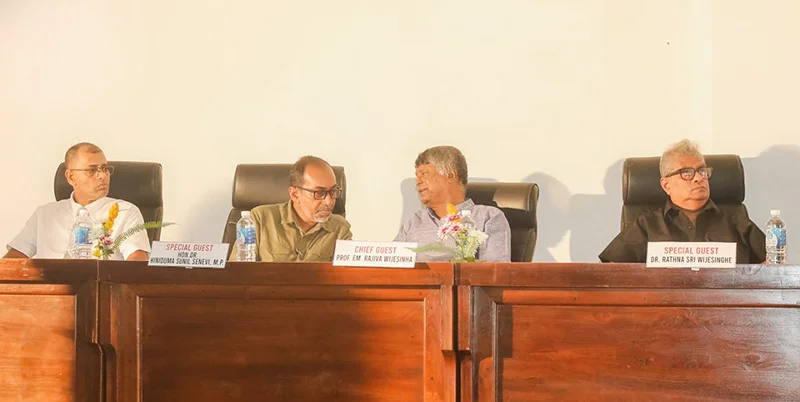
It is said that no man steps into the same river twice, for it is not the same river, and he is not the same man. These words came to mind upon reading Chandana Ruwan Jayanetti’s latest poetry collection, Poems from Galle, which inevitably invites comparison with his earlier work, particularly his first volume of poetry and prose, Reflections in Loneliness: A Collection of Poems and Prose (2015).
In this new collection, Jayanetti is demonstrably not the same poet he was a decade ago. His horizons have widened. his subject matter has diversified, and his thematic range has deepened. The earlier hallmarks of his work, including his empathetic attention to human experience, sensitivity to the natural world, and intimate, reflective tone, remain present. Yet they are now complemented by a stronger defiance, a more deliberate engagement with the political and the cosmic, and a broader mosaic of local and universal concerns. His poetic voice has evolved in scope, tonal range, and thematic ambition.
My own acquaintance with Jayanetti’s poetry dates back to our undergraduate days at Sabaragamuwa University of Sri Lanka, where we were classmates pursuing a BA in Languages (English Special). Even then, his work revealed precise observational skill coupled with profound sympathy for individuals. This early sensibility found fuller articulation in Reflections in Loneliness, a collection spanning nearly two decades of creative endeavor.
That inaugural volume traversed a wide thematic landscape: childhood memories; tender compassion toward humans and animals; tributes to the deserving; the joys and sorrows of young love; and reflections on Sri Lanka’s three-decade Northeast conflict, which concluded in 2009. Jayanetti’s verse, written with sincerity and empathy, moves fluidly from deeply personal to universally human. Moments of striking poignancy include the loss of his wife’s mother, the death of a young friend who marched unflinchingly to the warfront, and the bittersweet parting from a lover.
The prose section of Reflections in Loneliness offered a return to the rural simplicity of the 1970s and ’80s through the perspective of a schoolboy. Essays such as We Buy a Bicycle, Television Descends, The Village Goes to the Fair, Bathing Excursions and Hingurakanda evoke a bygone era with unvarnished authenticity. As literary critic Kamala Wijeratne noted, Jayanetti’s prose merited commendation for its perceptive and affectionate portrayal of rural life, written with the authority of lived experience. His meticulous attention to minute details revealed not only the flaws and frailties of human nature but also its loyalties and quiet virtues, articulated with unforced sympathy.
Consisting of 31 poems and five prose pieces, Reflections in Loneliness established Jayanetti as a writer of elegance, precision, and emotional depth. The current collection, however, confirms the Heraclitean and Buddhist insights: both the poet and his poetry have changed. The new work reflects an expansion from the personal to the cosmic, from the intimately local to the globally resonant, a testament to an artist in motion, carried forward by the ever-changing current of his creative life.
Jayanetti’s poetic corpus in the new book Poems from Galle, spanning thirty-five evocative works from They Heard the Cock Crow to A Birthday Celebration, reveals a profound and consistent artistic signature rooted in themes of humanity, nature, history, and social consciousness. Throughout these poems, Jayanetti demonstrates a distinctive voice that is simultaneously empathetic, contemplative, and alert to the complexities of his Sri Lankan heritage and the broader human condition. While maintaining a core of thematic and tonal consistency, each poem enriches this foundation by expanding into new dimensions of experience, whether personal, ecological, political, or historical.
A foundational element of Jayanetti’s poetry is the intimate relationship between humans and nature, frequently underscored by a deep ethical awareness. In poems like From a Herdman’s Life and My Neighbor, he gives voice to the quiet dignity of rural existence and animal companionship, portraying a symbiotic bond imbued with mutual care and respect. Similarly, Fallen Elephant and Inhumanity lament the cruelty inflicted upon majestic creatures, indicting human greed and violence. These poems articulate not only empathy for the natural world but also an implicit call for stewardship, threading a moral sensibility throughout the collection.
This concern extends to the socio-political sphere, as Jayanetti often situates his poems within the fraught realities of Sri Lanka’s history and struggles. Homage to Sir Henry Pedris honors a national martyr, while Confession of a Sri Lankan Cop exposes institutional corruption and personal integrity in tension. Hanuma Wannama and Gone Are They tackle political violence and social upheaval, reflecting the poet’s engagement with national trauma and collective memory. These works enrich the thematic landscape by connecting personal narrative to larger historical forces.

Jayanetti’s choice of subjects is remarkably diverse yet unified by a focus on lived experience—ranging from the intimate (To a Puppy That Departed, Benji) to the grand (Mekong, A Voyage). The poet’s attention to place, whether the Sri Lankan cityscape in City Morning and Evening from the College Terrace or the historic Ode to Galle Fort, anchors his work in locality while evoking universal themes of time, change, and belonging. Even poems centered on seemingly mundane moments, such as Staff Meeting or A Game, are elevated by the poet’s keen observational eye and capacity to find meaning in everyday rituals.
Moreover, Jayanetti often draws from historical and cultural memory, as seen in Ludowyk Remembered, Let Ho Chi Minh Guide You, and Rathna Sri Remembered, positioning his poetry as a dialogue between past and present. This choice expands his thematic range to include legacy, identity, and the power of remembrance, linking the individual to the collective consciousness.
Across the collection, Jayanetti’s tone is marked by a blend of gentle empathy and quiet strength. Poems such as A Companion Departed and To a Puppy That Departed convey tenderness and mourning with understated poignancy. His voice is intimate and accessible, inviting readers into personal reflections suffused with emotional depth.
Yet, this empathy is balanced by moments of stark realism and defiance.
In Corona and Hanuma Wannama, the tone shifts to urgent and accusatory, critiquing social injustice and political decay. A Ship Weeps mourns environmental devastation with an elegiac voice that is both sorrowful and admonitory. This tonal range reveals a poet capable of both consolation and confrontation, who embraces complexity rather than sentimentality.
While many poems explore specific moments or relationships, others invite contemplation on broader existential and cosmic themes. For instance, A Voyage and Mekong traverse spatial and temporal boundaries, evoking the interplay between human journeys and natural cycles. A Birthday Celebration reflects on legacy, learning, and the continuum of knowledge, blending personal homage with universal insight.
Even poems like A Bond and A Game gesture toward symbolic resonance, the former exploring interspecies loyalty as a metaphor for fidelity and duty, the latter invoking sport as a microcosm of life’s challenges and hopes. These works demonstrate Jayanetti’s ability to expand familiar motifs into metaphoric and philosophical territory, enriching his poetic landscape.
Jayanetti’s thirty-five poems in Poems from Galle collectively reveal a consistent and compelling artistic signature that intertwines compassionate engagement with nature and society, a profound sense of place, and an acute awareness of history and memory. His voice navigates seamlessly between moments of intimate reflection and urgent social commentary, creating a poetic landscape that resonates with both specificity and universality.
Each poem adds a distinct dimension to this mosaic. Historical and political awareness emerges strongly in poems like Let Ho Chi Minh Guide You and Homage to Sir Henry Pedris, where the sacrifices of national heroes and struggles for justice are evoked with reverence and clarity. Meanwhile, environmental consciousness is vividly articulated in works such as Abandoned Chena, Kottawa Forest, and Fallen Elephant, where the fragility of ecosystems and the human impact on nature are poignantly explored.
Jayanetti also delves deeply into themes of personal loss and companionship in poems like Benji, A Companion Departed, and In Memory of Brownie, tenderly capturing the bond between humans and animals. Poems like Confession of a Sri Lankan Cop and Hanuma Wannama offer raw social critique, revealing layers of political and moral complexity.
Through this interplay of historical, environmental, personal, and political themes, Jayanetti constructs a body of work that is distinctly Sri Lankan in its cultural and geographical grounding yet profoundly universal in its exploration of human experience. His poetry invites readers to reflect on the interconnected fates of humans, animals, and the natural world, urging a deeper awareness of our shared existence and responsibilities.
by Saman Indrajith
-
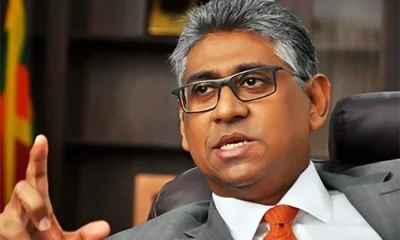
 News17 hours ago
News17 hours agoBroad support emerges for Faiszer’s sweeping proposals on long- delayed divorce and personal law reforms
-
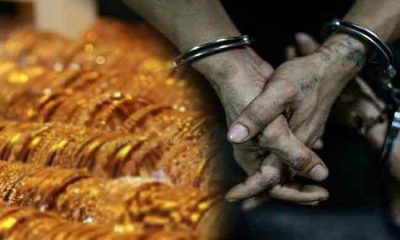
 News2 days ago
News2 days agoPrivate airline crew member nabbed with contraband gold
-

 News4 days ago
News4 days agoHealth Minister sends letter of demand for one billion rupees in damages
-

 Opinion6 days ago
Opinion6 days agoRemembering Douglas Devananda on New Year’s Day 2026
-
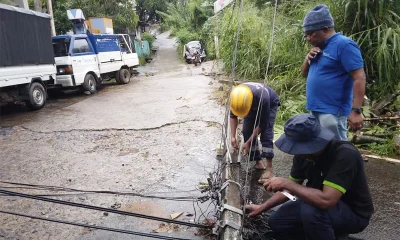
 News7 days ago
News7 days agoLeading the Nation’s Connectivity Recovery Amid Unprecedented Challenges
-

 Features2 days ago
Features2 days agoPharmaceuticals, deaths, and work ethics
-

 News17 hours ago
News17 hours agoInterception of SL fishing craft by Seychelles: Trawler owners demand international investigation
-

 Latest News2 days ago
Latest News2 days agoCurran, bowlers lead Desert Vipers to maiden ILT20 title


